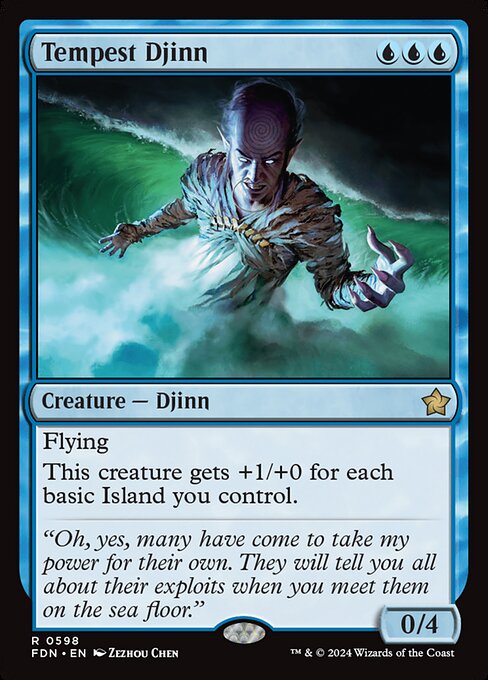
Image courtesy of Scryfall.com
A Blue Tempo Catalyst: Tempest Djinn and the Mid-Game Shift
Blue tempo decks love to weave a dance between disruption and inevitability, and Tempest Djinn slips into that rhythm with a sly grin. This legendary-feeling Djinn from Foundations—a rare reprint etched in Zezhou Chen’s sea-stormy art—brings a uniquely scalable threat to the table. You don’t cast Tempest Djinn to flood the board on the first turn; you stage a mid-game crescendo where the Djinn’s power climbs with every basic Island you control. 🧙♂️🔥🎲
On its face, Tempest Djinn is a three-mana flyer: a 0/4 body that costs UU U to cast. That’s a respectable, tempo-friendly stat line in blue—it arrives early enough to threaten a race if the coast is clear, yet it’s not a vanilla beatstick. The real trick lies in its evergreen ability: “This creature gets +1/+0 for each basic Island you control.” In other words, your fifth Island bumps it to a 5/4 flyer; your tenth Island makes it a 10/4 threat if the board state allows, all while staying unblockable by most ground-based forces thanks to flying. It’s the kind of effect that rewards careful land-tech: your Islands aren’t just mana they’re arithmetic accelerants. 🧊
The flavor text speaks to a creature who has watched power-seekers try to cage the sea-floor’s energy. “Oh, yes, many have come to take my power for their own. They will tell you all about their exploits when you meet them on the sea floor.” That line isn’t just flavor; it’s a hint about tempo games: Tempest Djinn wants to be found late enough to multiply your board advantage, but early enough to protect your control if your opponent tries a quick strike. In practice, you’ll time your Djinn to exploit the moment when your Islands outnumber their answers, turning a sneaky evasive threat into a crashing tempo play. ⚓️💎
Build around the key idea: Islands as the engine
- Mana base for UUu: You’ll want a blue-centric deck with reliable access to multiple Islands. The card’s mana cost is a blunt reminder that your tempo is built on land selection as much as spell pressure.
- Evasion and tempo synergy: Flying lets Tempest Djinn dodge many early blockers, letting you push damage while you prep the next island chain. You’re not trying to hard-cast it on turn three and slam a 6/4; you’re curating a timeline where the Djinn blossoms into a mid-game behemoth that opponents can’t simply race down. 🪶
- Protection and resilience: Blue can answer removal, counter threats, and retake the board. The Djinn thrives when you keep counter-magic or bounce spells in your back pocket to maximize its mid-game spike while keeping your life total in a sweet spot.
- Deck considerations: Because the pump depends on basic Islands, card choices that fetch or fetch-for basics can alter the math in your favor. Similarly, draw spells and cycling can help you reach the point where you have enough Islands in play to push a decisive advantage.
From a design perspective, Tempest Djinn embodies a classic tempo arc: you invest minimal mana early to secure air-c cover, then you leverage a growing attack that scales with your land drop count. The card’s rarity in Foundations (FDN), a core-set callback, reinforces blue’s identity as the library of clever misdirection and late-game inevitability. And while it’s not a crown jewel in every format, it can shine in a control-leaning or mid-range shell where your Islands multiply your threat and force adversaries to answer not just a single creature, but a growing wave of power. ⚔️
“The sea teaches patience, and patience teaches power.” Tempest Djinn embodies that lesson: it rewards you for carving out the tempo, letting your islands stack up power until your opponent’s defenses buckle under a hard-to-block flyer that suddenly becomes a mountainous threat.
Strategically, Tempest Djinn sits at an interesting intersection. It’s not a one-turn swing; it’s a tempo engine. If you can hold a stable board with counterspells or removal back-up, you can drop the Djinn into a moment when your opponent has committed to a line of play that you can redirect with a timely bounce or an extra island drop. The result is a multi-turn sequence where you convert incremental advantage (the gradual ramp in power) into decisive pressure. In this sense, Tempest Djinn isn’t merely another creature; it’s a tempo pivot—one that can flip a tight race in your favor as your Island count climbs. 🌀
While the card’s numbers might look modest at first glance, they tell a different story once you map out the late-game landscape. A board of three or four Islands can push Tempest Djinn into a comfortable 3/4 or 4/4 profile, often enough to challenge your opponent’s plan while you draw into additional disruption or card advantage. The real thrill is watching that number creep higher as you untap to draw and deploy more islands, turning a cautious mid-game into a confident late-game march. And yes, it’s the sort of moment that invites a little dramatic narration from your local playgroup—the moment where tempo finally tips the scale. 🎨
For collectors and players who enjoy the theater of blue spells, Tempest Djinn also reflects a certain nostalgia: the idea that the sea-floor is not just a setting but a source of dynamic, scalable power. It’s a reminder that even a core-set reprint can bring a fresh angle to deck-building philosophy—how a single ability can redefine tempo and threaten across multiple turns. If you’re planning a blue tempo strategy, this Djinn is a thoughtful centerpiece that rewards disciplined land management and timely spellcraft.
Non-slip Gaming Mouse Pad with Polyester SurfaceMore from our network
- https://crypto-acolytes.xyz/blog/post/how-artificial-scarcity-is-reshaping-virtual-world-economies/
- https://crypto-acolytes.xyz/blog/post/must-play-free-to-play-pc-games-you-havent-tried/
- https://blog.digital-vault.xyz/blog/post/how-to-design-editable-certificate-templates-for-every-event/
- https://crypto-acolytes.xyz/blog/post/crafting-mastery-the-key-to-survival-games-success/
- https://crypto-acolytes.xyz/blog/post/blue-giant-seven-thousand-light-years-away-tests-astrometric-precision/